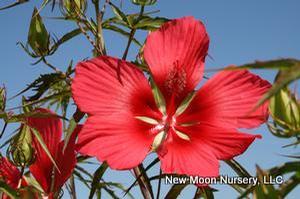Printed at http://www.newmoonnursery.com/index.cfm/
Hibiscus coccineus
Scarlet rose mallow
Native to North America
FIRST IMPRESSIONS: Hibiscus coccineus is a striking tall boy that injects architectural interest into the late summer garden. This robust wildflower has sturdy stems with bold palmately lobed leaves. In summer, plants are crowned by large striking red flowers similar to those of the tropical hibiscus. The blooms are solitary and axillary with 5 slender petals and a starry shape. This species thrives in sunny moist or wet sites where it is much loved by ruby throated hummingbirds.
HABITAT & HARDINESS: Hibiscus coccineus occurs from Virginia to Florida and west to east Texas. The widest distribution is in Florida.
Plants are indigenous to Coastal Plain ditches, edges of brackish or freshwater swamps, marshes and low soggy margins of rivers or ponds.
Plants are hardy from USDA Zones 6-9.
PLANT DESCRIPTION: Hibiscus coccineus is a narrow upright perennial with multiple mostly unbranched stems.
After a winter dormancy, glabrous stems quickly soar toward the sky. They are clothed in large unique palmately lobed leaves with long petioles. the blades consist of 3, 5, or 7 pointed toothed lobes. The foliage often reminds the uninitiated of Cannabis sativa.
From summer until early autumn spectacular crimson saucer shaped flowers are borne in the plant’s upper leaf axils. Each bloom is 4-6” across with 5 lustrous narrow ribbed petals.
Each bloom lasts only a day but they are produced in large numbers. Attractive 1-2” capsules form after flowering.
Plants are 5-8’ tall with a spread of 2-3’.
CULTURAL & MAINTENANCE NEEDS: Hibiscus coccineus prefers sunny exposures with rich wet to moist soils. Plants tolerate clay, muck, silty sand and shallow standing water.
Stems are sturdy and rarely need staking. Plants are native to boggy sites but are fairly drought tolerant after establishment in the garden.
Gardeners generally cut dried stems to the ground in late winter to “tidy” the garden. This timing allows the stalks with their angular capsules to inject winter interest.
This species is fairly pest resistant but young plants are occasionally nibbled by deer.
LANDSCAPE USES: Hibiscus coccineus is a dramatic Accent for a Wildlife Garden or Water Garden. Plants are also used as Butterfly Nectar Plants or as part of a Grouping or Mass Planting. This wildflower has Showy Blooms and provides Erosion Control. It can be used in Cottage Gardens, Rain Gardens, Water-wise Landscapes, Low Maintenance Plantings, Perennial Borders, Roadsides and Wetlands.
COMPANION & UNDERSTUDY PLANTS: Try pairing Hibiscus coccineus with Asclepias incarnata, Eupatorium perfoliatum, Helianthus angustifolius, Lobelia cardinalis and Panicum virgatum.
Hibiscus moscheutos is a worthy substitute with similar flowers and cultural needs.
TRIVIA: Hibiscus coccineus was encountered by the William and John Bartram in Florida in 1765. William Bartram produced a botanical painting of the flower and John Bartram wrote in his journal that it was the “most stately of all herbaceous plants…” Seed or plants were collected or purchased by George Washington and Thomas Jefferson and established at Mount Vernon and Monticello. In 1839 this species was endorsed for garden use in The American Flower Garden Dictionary.
Blooms provide nectar to a variety of pollinators including the specialist Rose Mallow Bee and Ruby Throated Hummingbirds. Plants host caterpillars of gray hairstreak, painted lady butterflies and several moths and skippers.
Plants are sometimes called Texas Star Hibiscus or Swamp Hibiscus.
Height:
5-8 ftSpread:
2-3 ftSpacing:
2-4 ftUSDA Hardiness Zone:
6-9Bloom Color:
RedHibiscus coccineus Characteristics
Attracts Wildlife
- Butterflies
- Hummingbirds
Attributes
- Long Blooming
- Favorite
- East-Coast Native
- Rain Garden
- Coastal
- Bog
- Reblooming
- Naturalizing
Exposure
- Full Sun to Partial Shade
Flowering Months
- September
- August
- July
- June
Foliage Color
- Green
Salt Tolerance
- Low
Soil Moisture Preference
- Wet to Moist
Interesting Notes:
For more information on this plant, visit the USDA PLANTS Database: http://plants.usda.gov/java/profile?symbol=hico2

